Global S&T Development Trend Analysis Platform of Resources and Environment
| Where’d You Get Those Genes? Individual Growth Can Vary Wildly When Populations Interbreed | |
| admin | |
| 2020-03-12 | |
| 发布年 | 2020 |
| 语种 | 英语 |
| 国家 | 美国 |
| 领域 | 资源环境 |
| 正文(英文) |  Copepod Tigriopus californicus Scientists at Scripps Institution of Oceanography at UC San Diego have discovered why some hybrids between populations of the same species don’t develop as well as others, and the answers lie in their genes. “When individuals from different populations of the same species interbreed, there is often ‘hybrid vigor’ in the first generation, meaning that the offspring have improved function and fare well,” said Ron Burton, a professor of marine biology at Scripps. However, when this generation produces offspring, the second generation hybrids show a range of fitness levels – in this study defined as growth rate – with many doing quite poorly. These findings from this study have broad implications for conservation initiatives in which people introduce or move formerly separated populations, and as populations migrate due to climate change and other environmental stressors. Although each population may be intrinsically healthy, incompatibilities between DNA types between populations may result in reduced fitness when populations interbreed. The findings were published March 10 in the Proceedings of the National Academy of Sciences. Burton and postdoctoral scholar Timothy Healy discovered the genetic explanation for such variances in the National Science Foundation-funded study. Using two separate populations of the intertidal copepod Tigriopus californicus, a microscopic aquatic crustacean, they found that the answer lies in the interaction of nuclear DNA and mitochondrial DNA. Most DNA is housed in the nucleus of a cell, but mitochondria, where most energy in the cell is produced, also have a small amount of their own kind of DNA, called mtDNA. As in humans and other animals, copepods’ nuclear DNA is inherited from both the mother and father, but mtDNA is only inherited from the mother. The two types of DNA work together to determine the overall fitness of the individual. If the nuclear DNA doesn’t pair well with the mtDNA, mitochondrial function can be impaired and growth rate is jeopardized. Burton and Healy found that when populations of a species become isolated for long periods of time, nuclear DNA and mtDNA coevolve within each population. Mitochondrial DNA evolves faster, and thus nuclear DNA gradually evolves along with it. Evolution in each natural population leads to adaptations between the DNA types, even though they are inherited independently, keeping the population as fit as possible. Problems arise, however, when individuals from isolated populations interbreed. Burton and Healy collected populations of Tigriopus copepods from tidepools at two distant locations, one in San Diego and one in Santa Cruz. They bred the two populations together, and monitored how long it took the eggs to develop. The first generation of offspring showed the same fitness as the parents, with some showing accelerated growth . But when those hybrids were interbred, Burton and Healy observed a wild variance in growth rates of the eggs. To understand the genetic basis of such variance, the researchers extracted and sequenced the nuclear DNA and mtDNA from this second generation of hybrids and traced their origins. In the offspring having mtDNA from the San Diego population, fast developers had a higher than expected proportion of nuclear DNA also from San Diego, and slow developers did not. Similarly, in those with Santa Cruz mtDNA, Santa Cruz nuclear DNA was in excess in fast developers only. “High-fitness hybrids are not a random set of offspring,” said Burton. “Rather they are the ones that happened to receive a large portion of their genes derived from the same population as their mitochondrial DNA.” This means that evolution in each natural population has led to adaptation between the nuclear and mitochondrial genomes even though they are inherited independently. Hybridization breaks down this adaptation between nuclear DNA and mtDNA within populations resulting in poor mitochondrial function and reduced fitness in many hybrids. Healy added, “The surprising and most important finding of this study is that despite the fact that there are only 37 genes in the mtDNA, switching the source population of the mtDNA in these hybrids has a dramatic effect on the nuclear genome, which contains a much greater number of genes, over 15,000.” |
| URL | 查看原文 |
| 来源平台 | Scripps Institution of Oceanography |
| 文献类型 | 新闻 |
| 条目标识符 | http://119.78.100.173/C666/handle/2XK7JSWQ/229537 |
| 专题 | 资源环境科学 |
| 推荐引用方式 GB/T 7714 | admin. Where’d You Get Those Genes? Individual Growth Can Vary Wildly When Populations Interbreed. 2020. |
| 条目包含的文件 | 条目无相关文件。 | |||||
| 个性服务 |
| 推荐该条目 |
| 保存到收藏夹 |
| 查看访问统计 |
| 导出为Endnote文件 |
| 谷歌学术 |
| 谷歌学术中相似的文章 |
| [admin]的文章 |
| 百度学术 |
| 百度学术中相似的文章 |
| [admin]的文章 |
| 必应学术 |
| 必应学术中相似的文章 |
| [admin]的文章 |
| 相关权益政策 |
| 暂无数据 |
| 收藏/分享 |
除非特别说明,本系统中所有内容都受版权保护,并保留所有权利。
修改评论